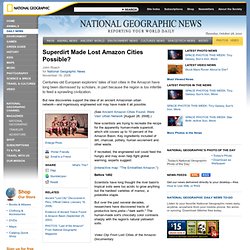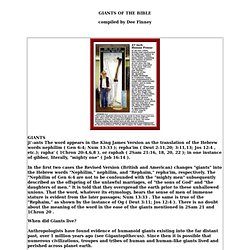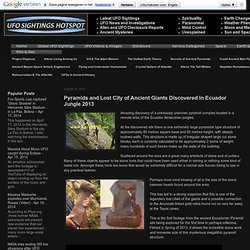

Mysterious Subterranean Water Channels Of Nazca Peru. Tiwanaku: Evidence Of Ancient Cataclysmic Destruction. NG Live!: Walking With Giants: How the Easter Island Moai Moved. Superdirt Made Lost Amazon Cities Possible? November 19, 2008 Centuries-old European explorers' tales of lost cities in the Amazon have long been dismissed by scholars, in part because the region is too infertile to feed a sprawling civilization.

But new discoveries support the idea of an ancient Amazonian urban network—and ingeniously engineered soil may have made it all possible. (See Ancient Amazon Cities Found; Were Vast Urban Network [August 28, 2008].) Now scientists are trying to recreate the recipe for the apparently human-made supersoil, which still covers up to 10 percent of the Amazon Basin. Key ingredients included of dirt, charcoal, pottery, human excrement and other waste. If recreated, the engineered soil could feed the hungry and may even help fight global warming, experts suggest. (Interactive map: "The Embattled Amazon. ") Before 1492 Scientists have long thought the river basin's tropical soils were too acidic to grow anything but the hardiest varieties of manioc, a potatolike staple. "Lost" Amazon Complex Found; Shapes Seen by Satellite. Hundreds of circles, squares, and other geometric shapes once hidden by forest hint at a previously unknown ancient society that flourished in the Amazon, a new study says.
Satellite images of the upper Amazon Basin taken since 1999 have revealed more than 200 geometric earthworks spanning a distance greater than 155 miles (250 kilometers). (Related: "Huge Pre-Stonehenge Complex Found via 'Crop Circles.'" ) Now researchers estimate that nearly ten times as many such structures—of unknown purpose—may exist undetected under the Amazon's forest cover. At least one of the sites has been dated to around A.D. 1283, although others may date as far back as A.D. 200 to 300, said study co-author Denise Schaan, an anthropologist at the Federal University of Pará in Belém, Brazil .
Since these vanished societies had gone unrecorded, previous research had suggested that soils in the upper Amazon were too poor to support the extensive agriculture needed for such large, permanent settlements. Easter Island. Ancient Structures That Will Take Your Breath Away. GIANTS OF THE BIBLE. Rephaim, or Giants: Glenn Kimball reports: Glenn photographed the mummies of two of these giant men in Lima Peru in 1969.

These giants are still in the gold museum in Lima Peru today and can be seen by anyone who visits. They were mummified because their golden robes are prominently on display. Their crowns could fit around Glenn’s waist. These were not mutations. This isn’t the only time Giants were mentioned by prominent people who visited South America. When Diego de Ordaz climbed to the high volcano of Popocatepetl, near Mexico City, according to Las Casas, he found a giant thigh bone that he sent to the Vatican. In the summer of 1931 Monsignor F. This race of ancient white giant men with beards was called the Viracochas. At the ruins of Pachacamac where US and British archeologists and the Carnegie Institution are working today, the giants are mentioned. These giants were granted a state of quasi-unprotected immortality by deity. Daniel met some of them. Legends of the Giants in Ancient Mexico IV. REAL GIANTS OF THE ANCIENT WORLD - Tracking Goliath.
Findings of Unusual Human Remains. Pyramids and Lost City of Ancient Giants Discovered in Ecuador Jungle 2013. Amazing discovery of a previously unknown pyramid complex located in a remote area of the Ecuador Amazonian jungles.

At the discovered site there is one extremely large pyramidal type structure of approximately 80 metres square base and 80 metres height, with steeply inclined walls. This structure is made up of irregular shaped large cut stone blocks, each is currently calculated to be approximately 2 tonne of weight, many hundreds of such blocks make up the walls of the building. Scattered around the area are a great many artefacts of stone and of pottery. Many of these objects appear to be stone tools that could have been used either in mining or refining some kind of metal ore. Amongst these tools are some that would be extremely difficult for a normal size human being to use in any practical fashion.